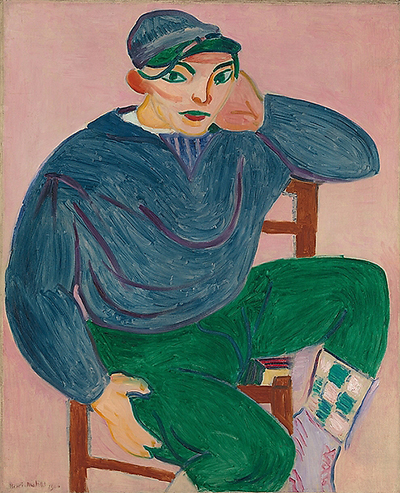Henri Matisse would spend a fruitful few summers in Landscape at Collioure, on the French-Spanish border in the early 20th century. Two portraits of a young sailor was part of his output here.
The artist is believed to have first visited this region in 1905 before returning many times for the next decade or so. He came across this young sailor on his first visit and immediately wanted to arrange a sitting for a portrait. The young man's name was Germain Augustin Barthélémy Montargès and he would have been just 18 years of age at the time. No doubt, someone with such a simple lifestyle in a fairly quiet location would have been both flattered but also bemused to have been chosen for this task, but its success in the eyes of Matisse is shown in that there were at least two different paintings produced from their time together. The artist was perhaps interested both in the natural good looks of this young man which made him an ideal model, but also in the genuine occupation that he was involved in, as his clothing demonstrates - clearly the artist did not wish to disguise this.
Both The Young Sailor I and this follow up piece came about in 1906, one year after the artist first arrived in this destination. The original was looser technically, more expressive and almost like a study experiment. Here, however, the areas of colour are much more solid and it all feels a little more complete. The artist chooses the same pose again, but the facial expression looks a little more relaxed, perhaps because the young sitter was now more comfortable in Matisse's company. Overall, the palette here is relatively narrow, with the same tone of blue used for the sailor's cap and coat. His bright green trousers look stunning when set against the light pink background. There is no clash of colour as seen in the Fauvist movement here, but the colours are bright and contemporary, none the less.
It could be that these two paintings serve as important examples of the development of the artist, as he would work in this style of large areas of single colours for the next few years after this point. This second iteration is now in the Metropolitan Museum of Art in the US and has been exhibited frequently since around 1910, though it only arrived into the care of this institution in around 1998 as a result of a generous donation from the Jacques and Natasha Gelman Collection. This impressive venue has acquired thousands of items over the years through private purchases and also donations that still continue to flood in today, often from collectors who themselves have enjoyed visiting the gallery within their own lifetime. This second portrait helps us to also understand the lives of those in this part of Southern France during the early 20th century, with subtle information being gleaned from the various artworks that Matisse produced here over a period of several years.




